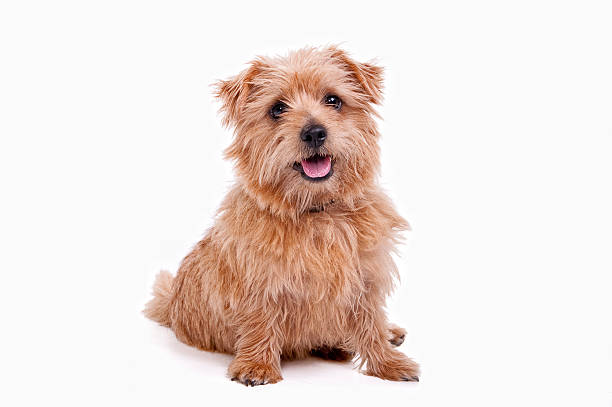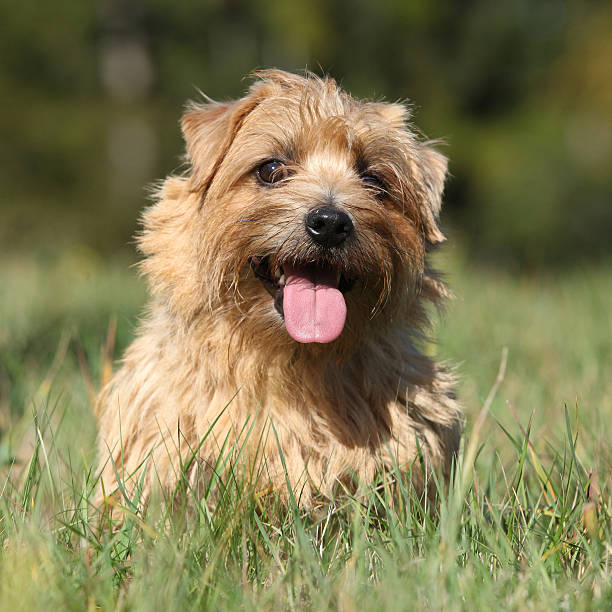Norfolk Terrier

Breed History:
The Norfolk Terrier was developed in East Anglia, England, during the late 19th and early 20th centuries. It shares its roots with the Norwich Terrier, and the two were once considered a single breed. The key difference lies in the ears—Norfolk Terriers have drop ears, while Norwich Terriers have prick ears.
Originally bred to hunt vermin on farms and accompany foxhunts, the Norfolk Terrier was valued for its bravery, small size, and ability to go to ground after prey. It was officially recognised as a separate breed by the Kennel Club (UK) in 1964 and by the American Kennel Club in 1979.
Height: 23-25 cm
Weight: 5-6 kg
Size – Small
Life Expectancy: 12–15 years

Breed Appearance:
The Norfolk Terrier is one of the smallest working terriers, with a compact, strong body and a slightly rounded head. It has expressive dark eyes, a strong jaw, and characteristic drooping ears that hang close to the cheeks.
The coat is hard, wiry, and straight, with a dense undercoat that protects against harsh weather. It typically comes in shades of red, wheaten, black and tan, or grizzle. The tail is often medium in length and carried high when alert.
Breed Type – Companion/Vermin Hunter:
True to its terrier heritage, the Norfolk is bold, energetic, and full of character. Despite its size, it is a true working dog with a fearless attitude.
Norfolks are affectionate and sociable with their families, making them excellent companion animals. They typically get along well with respectful children and can coexist with other dogs, though their prey drive may cause them to chase smaller animals.

Training:
The Norfolk Terrier is intelligent and eager to please, but can also be independent and feisty. Early training and socialisation are essential to ensure good manners and adaptability.
Use positive reinforcement techniques—these dogs respond well to praise, treats, and play. Consistent, short, and fun training sessions work best.
Health & Care:
Generally healthy, the Norfolk Terrier may be prone to the following conditions:
-
Mitral valve disease (heart)
-
Hip dysplasia (though rare in small breeds)
-
Patellar luxation
-
Eye issues (e.g., cataracts)
Routine health screenings and regular vet checkups are important. Maintaining a healthy weight and providing quality food support long-term well-being.

Living Conditions:
The Norfolk Terrier adapts well to various living situations, from apartments to rural homes. However, it thrives on companionship and shouldn't be left alone for extended periods.
Secure fencing is essential, as their hunting instincts may lead them to dig or escape in pursuit of prey. Indoors, they are active but not hyper.
Exercise:
This breed has moderate exercise needs. Aim for 45 minutes to 1 hour of daily activity, including walks, play sessions, or interactive games.
They enjoy digging, chasing, and exploring, so access to a secure yard is ideal. Mental stimulation, such as food puzzles and obedience tasks, also helps keep them content.
Grooming:
-
Weekly brushing keeps the wiry coat clean and tangle-free
-
Hand-stripping several times a year helps maintain texture (especially for show dogs)
-
Bathe only when necessary
-
Regular ear cleaning, nail trimming, and dental care are essential
Norfolks are moderate shedders when not hand-stripped but relatively low-maintenance overall.

Advantages:
-
Cheerful, loyal, and affectionate companion
-
Small but sturdy, good with children
-
Intelligent and trainable
-
Adaptable to both urban and rural environments
-
Minimal grooming needs if kept as a pet
-
Typically good with other dogs
Disadvantages:
-
Can be stubborn or independent
-
Strong prey drive; not safe with small animals
-
May bark frequently without training
-
Needs regular attention and stimulation
-
Prone to digging if bored or unsupervised
-
Requires professional grooming (hand-stripping) for show standards

